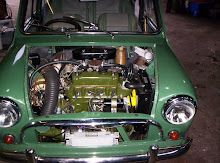With S.U. carburettors, poor performance is most likely to be caused by a sticking piston, failure to top-up the piston damper chamber, or the use of too thin an oil in the damper. It must again be emphasized that it should not be necessary to change the size of the jet needle if the car has previously been behaving normally. If, however, a slightly better performance than standard is required, the effect of the "rich" needle recommended by the local agents can be tried; naturally, if the increased performance is used, some deterioration in fuel consumption must be expected.
Maximum speed is also controlled to a limited extent by the jet needle and here again a "rich" needle can be tried if it is desired to increase the speed—a step which would normally not be contemplated by the average
owner since the car is not designed for very high maximum speeds but rather for reasonable cruising speeds, good acceleration and a high degree of economy. It is seldom satisfactory to attempt to obtain any consider¬able increase in performance by minor alterations to the carburation and ignition settings alone.
A fault which sometimes crops up is the cutting-out of the engine when left-hand corners are taken fast, owing to a small globule of water accumu¬lating in the pipe connecting the float chamber to the base of the carburettor jet. Normally the water lies at the bottom of the bend in the pipe. On a right-hand corner it merely flows back towards the float chamber, but when a left-hand bend is taken it may roll into the jet, causing the engine to cut-out momentarily.
It is difficult to ensure that no water enters the fuel, as a certain amount of condensation is bound to take place. On early cars the trouble was aggravated by the fact that the petrol tank breather pipe was placed in such a position that water was forced up it and into the tank when the car was being driven in very wet weather. This fault applied only to a few thousand cars, however, and was quickly rectified.
When water does accumulate in the jet feed pipe, it is a comparatively simple matter to disconnect the pipe and drain off the water and, incident¬ally, any sediment which has also accumulated.
Thursday, 15 October 2009
Lack of Power and Poor Acceleration
Posted by Info Mini Cars at 04:24
Subscribe to:
Post Comments (Atom)


0 comments:
Post a Comment